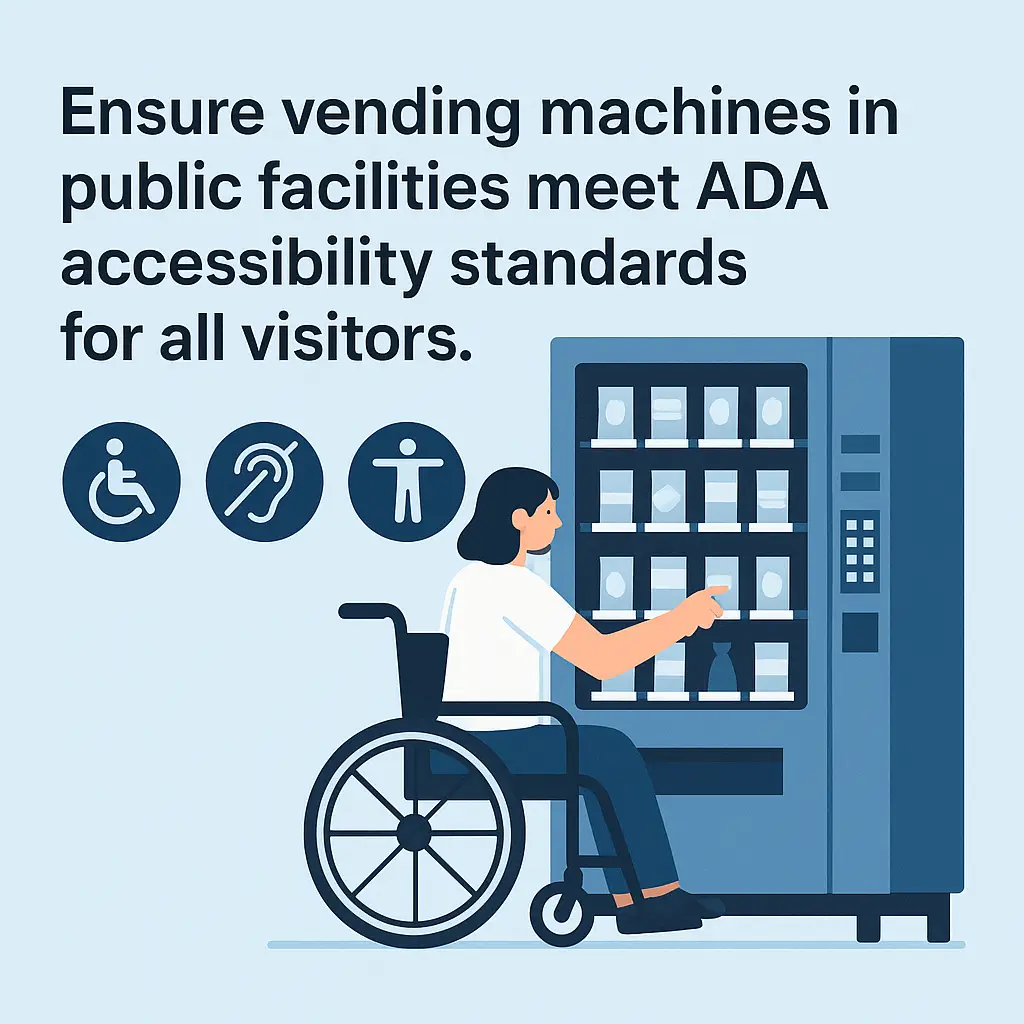Accessibility in Public Building Vending Machines
Ensure vending machines in public facilities meet ADA accessibility standards for all visitors.
Back to Vending for Public Buildings ResourcesEnsure vending machines in public facilities meet ADA accessibility standards for all visitors.
Back to Vending for Public Buildings ResourcesADA standards cover reach ranges, operable parts, and accessible routes to ensure that all users can independently use vending machines in public facilities.
![]() ADA-compliant vending ensures inclusive access for all visitors
ADA-compliant vending ensures inclusive access for all visitors
![]() Proper placement improves usability for wheelchair users and others
Proper placement improves usability for wheelchair users and others
![]() Accessible payment options support equitable service for everyone
Accessible payment options support equitable service for everyone

Ensuring that vending machines in public buildings are accessible to everyone is more than a legal requirement—it’s a critical step toward creating inclusive environments. Meeting ADA standards helps all visitors, including individuals with disabilities, use vending equipment independently and comfortably.
The Americans with Disabilities Act (ADA) provides clear guidelines for how vending machines should be installed and operated. These standards cover reach ranges, operable parts, and the space required for wheelchair users to maneuver. By following these guidelines, facilities can avoid compliance issues while offering fair access to all.
Placement plays a major role in accessibility. Machines should be positioned so that controls and payment interfaces fall within the standard ADA reach range of 15 to 48 inches above the floor. Clear floor space in front of each machine allows wheelchair users to approach and use them easily. Strategic placement can also reduce congestion and improve the flow of visitors through public spaces.
Modern vending technology supports a range of features that enhance accessibility. Tactile buttons, audio prompts, and screen contrast adjustments can assist users with different needs. Offering contactless payment methods ensures that individuals who may have difficulty with coin or bill acceptors can still make purchases conveniently.
Compliance doesn’t end after installation. Regular maintenance helps keep machines functioning as intended, preventing accessibility features from becoming unusable over time. Facility managers should also establish clear policies for monitoring compliance and responding to accessibility complaints quickly and effectively.
For additional guidance on creating equitable vending experiences, explore topics such as security measures in public vending and commission opportunities for public facilities. You can also review examples like City Hall’s successful vending implementation to see accessibility in action.
If you're exploring vending options for your business, Vending Exchange can help simplify the process. Delivery, Installation and Equipment is provided at no cost to you - vendors provide the machines, keep them stocked, and handle all servicing. Whether you need a provider or full-service management, just fill out the form on this page to get started.
ADA guidelines cover reach ranges, operable parts, and accessible routes to ensure all visitors can use vending machines independently.
Machines should have controls 15–48 inches above the floor and clear floor space in front for easy approach.
Accessible setups often include contactless payment options and tactile buttons to accommodate diverse needs.
Regular maintenance ensures buttons, screens, and payment systems remain fully functional for all users.
Yes. Audio cues assist individuals with visual impairments by guiding them through the purchase process.
Existing machines may need adjustments during major alterations or relocations to align with accessibility requirements.
Routine inspections, feedback channels, and clear oversight policies help maintain long-term compliance.
The ADA recommends operable parts between 15 and 48 inches from the floor for accessibility.
Without tactile or audio alternatives, touchscreens can be difficult for some users, so alternative options are recommended.
The facility owner or manager typically holds responsibility for ensuring machines meet accessibility requirements.